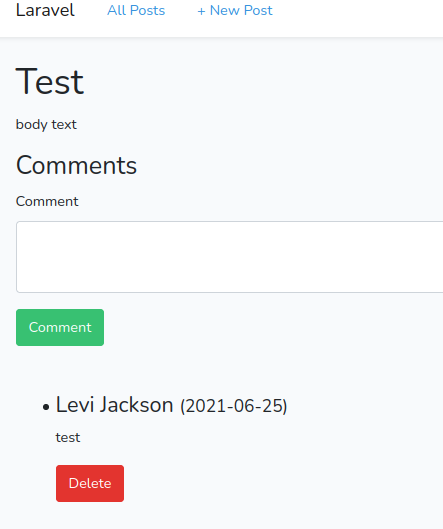Overview
- Part 1: Walk-through installing and configuring Laravel
- Part 2: Create the core models/tables, controllers, and views
- Part 3: Authorization/Login
- Part 4: Post CRUD
- Part 5: Comment CRUD
- Part 6: Validation
- Part 7: Testing
At the end of this you'll have a blog post view like this

New post form
- Make a new folder for the blade files
mkdir resources/views/blog/comments/
- Add new
CommentController
./vendor/bin/sail artisan make:controller CommentController
- Add a
savemethod + path (/admin/blog/comment) to the route file.
Add the route inside the /blog prefix group.
# routes/web.php Route::post('/comment', 'App\Http\Controllers\CommentController@save');
# app/Http/Controllers/CommentController.php <?php namespace App\Http\Controllers; use Illuminate\Http\Request; use App\Models\Comment; class CommentController extends Controller { public function save(Request $request) { $comment = new Comment(); $comment->comment = $request->get('comment'); $comment->user_id = $request->user()->id; $comment->post_id = $request->get('post_id'); $comment->save(); return redirect() ->back(); } }
- Add the form to create a comment and add it to the single post view
# resources/views/blog/comments/create.blade.php <form action="/admin/blog/comment" method="post" class="container"> <input type="hidden" name="_token" value="{{ csrf_token() }}" /> <input type="hidden" name="post_id" value={{ $post->id }} /> <div class="form-group"> <label for="comment">Comment</label> <textarea name="comment" class="form-control"></textarea> </div> <input type="submit" name="submit" class="btn btn-success" value="Comment" /> </form>
Add the include to the blog post blade file so it displays the comment form.
# resources/views/blog/posts/single.blade.php <h3>Comments</h3> @include('blog.comments.create')
- Display comments on a post
We'll update the PostController to include the comments as view data.
$comments = $post->comments()->get(); return view('blog.posts.single', ['post' => $post, 'comments' => $comments]);
Add a new blade file for an individual comment
# resources/views/blog/comments/single.blade.php <li> <div> <h4>{{ $comment->author()->first()->name }} <small>({{ date('Y-m-d', strtotime($comment->created_at)) }})</small></h4> <p>{{ $comment->comment }}</p> </div> </li>
Update the single post blade file to loop the comments and render them.
# resources/views/blog/posts/single.blade.php @extends('layouts.app') @section('content') <div class="container"> <h1>{{ $post->title }}</h1> <p>{{ $post->body }}</p> <h3>Comments</h3> @include('blog.comments.create') <br /><br /> <ul class="comment-list"> @foreach ($comments as $comment) @include('blog.comments.single') @endforeach </ul> </div> @stop
- Add a way to delete a comment for admins only
Update the single post blade file to include a delete button.
# resources/views/blog/comments/single.blade.php @auth <form action="/admin/blog/comment/{{ $comment->id }}" method="post"> <input type="hidden" name="_token" value="{{ csrf_token() }}" /> <input type="hidden" name="_method" value="DELETE"> <input type="submit" name="delete" class="btn btn-danger" value="Delete" /> </form> @endauth
Add the route
# routes/web.php Route::delete('/comment/{commentId}', 'App\Http\Controllers\CommentController@delete');
Update CommentController to support the new delete route.
# app/Http/Controllers/CommentController.php public function delete(Request $request, int $commentId) { $comment = Comment::where('id', $commentId)->first(); if ($request->has('delete')) { $comment->delete(); $message = 'Comment deleted!'; } return redirect()->back(); }
Roundup
That's it for now. Part 6 will go through adding validation to ensure nothing breaks from user input.
Next: Validation